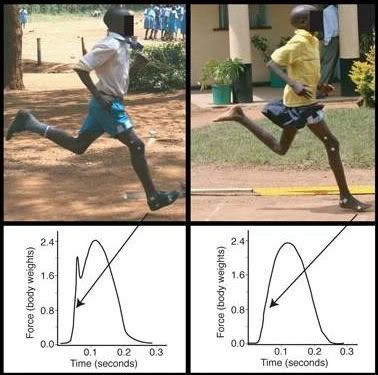>>>>本页
|
作为地球上跑得最快的马拉松运动员,Haile Gebrselassie在谈到他的早期运动生涯时曾说:“每当我穿上鞋就感到很难受。”如今一项新的研究揭示了其中的奥秘:人类穿鞋与光脚奔跑具有很大的差别。研究人员发现,运动鞋已经改变了我们,而后者的进化正是为了保护人体免受奔跑带来的冲击。这一发现为研究早期人类如何提供了新的视角,同时也进一步引发了人们对运动鞋所能带来的伤害可能比它所提供的保护还要多的关注。
据美国《科学》杂志在线新闻报道,大约200万年前,现代人的祖先进化出了用于奔跑的生理“设备”——长腿、大臀、脚掌的弹性构造,以及其他特征。运动鞋在上世纪早期还没有进入人们的视野,并且直到上世纪70年代才开始在全球流行起来。那么在这些具有特殊目的的鞋子发明之前,人类究竟是如何让自己舒服地奔跑呢?
作为一名跑步爱好者,美国哈佛大学的人类进化生物学家Daniel Lieberman决定找出其中的答案。他与同事对来自美国和肯尼亚裂谷省——这里因盛产耐力出色的跑步选手而闻名——的200名穿鞋及光脚的跑步者进行了研究。志愿者参与了一个有关鞋子的试验,这些成人包括那些从小到大一直穿鞋奔跑的人,那些从小不穿运动鞋但现在穿鞋的人,以及那些从来都不穿鞋的人。Lieberman的研究小组安排了一个测试,让每一组穿着鞋(ASICS GEL-Cumulus 10s或他们自己的鞋)奔跑以及光着脚奔跑,随后测量受试者的步态以及对身体的冲击。
研究人员立刻发现了一个差异——那些穿鞋的跑步者习惯于用脚跟着地,而光脚的跑步者则会用脚掌或脚板心着地。光脚者的奔跑方式导致脚掌的足弓、踝关节以及膝盖更加弯曲,并且使用了更多的脚掌和小腿肌肉,减弱了对身体的冲击,从而形成了更舒服的步态。随着双脚与地面——即测试所使用的跑道——发生碰撞,光脚跑步者仅仅经历了相当于自身体重0.5倍到0.7倍的冲击,反之用脚跟着地的穿鞋跑步者则经历了相当于1.5倍到两倍自身体重的冲击,两者之间竟然相差3到4倍。
Lieberman惊讶地表示:“我总是以为光脚跑步很疼、很疯狂。”实际上,这一发现表明,光脚能够减少疼痛和受伤的可能性,这是因为大部分的跑步损伤——例如胫骨和足底骨折——都是压力和冲撞导致的。研究人员在1月28日出版的《自然》杂志上报告了这一研究成果——其封面所展示的正是参加该项研究的肯尼亚青少年的脚。他们从不穿鞋,有时{yt}能跑20公里。研究人员指出,他们的脚是健康的、强壮的,而在不久前,每个人的脚都是这样。
美国盐湖城犹他大学的进化形态学家Dennis Bramble表示:“这真是一项有趣的研究。”他说:“对脚跟的撞击让你不再想穿上这些人类所独有的{yl}跑鞋,我们所做到的其实要比我们能够做到的少。”Bramble认为:“这证明了我们自始至终应该知道:我们需要赤足奔跑。”
这项研究为一场正在进行的争论添了一把柴。光脚跑步的方式在过去的10年中得到了一定的推广,在跑步界随即出现了这样一种争论:光脚和穿鞋到底哪个更好?
那么运动员是否应该扔掉他们的跑鞋并加入光脚大军呢?“也不全是这样。”Lieberman指出,“穿鞋更舒服,并且它们保护双脚”能够在城市的玻璃、沥青和粗糙地面上行进。实际上,现在偶尔光脚跑步的 Lieberman建议对于光脚跑步应该有一个逐渐适应的过程,以便让脚掌和小腿缓慢适应并避免受伤。

Long-Awaited Barefoot Running Study Finds Sneakers Are Harmful
All the latest footwear engineering in your running sneakers might not mean a thing when it comes to preventing injuries. The latest barefoot running study in the journal Nature deployed 3-D infrared tracking to gauge the difference in foot strike between shod and shoeless runners, Scientific American reports. Here’s a modern-day meme summation of the findings: "Shoes? You’re doing it wrong."
Runners who wore sneakers ended up landing heel-first 75 to 80 percent of the time. By contrast, barefoot runners usually land toward the middle or front of the foot — a dramatic difference that recalls the more natural foot strike of early Homo sapiens. Needless to say, early humans certainly were not born to run wearing Nike or Reebok.
The heel-landing without shoes means a painful collision force of 1.5 to 3 times human body weight. But cushioned sneaker heels have allowed runners to change their stride to high-impact running, and likely open up a whole world of pain involving foot and leg injuries.
"Most people today think barefoot running is dangerous and hurts," said Daniel Lieberman, a professor of human evolutionary biology at Harvard University and lead author on the study. "But actually you can run barefoot on the world’s hardest surfaces without the slightest discomfort and pain."
Lieberman and his colleagues point out that modern running shoes did not come about until the 1970s — a fairly late invention that latched onto that then-new fad known as jogging (or "yogging" as Ron Burgundy says). Now contrast several decades of sneakers with a human body that evolved barefoot running over thousands of years, and you begin to see a potential problem.
More bad news for sneakers came last December, when the American Academy of Physical Medicine and Rehabilitation found that running shoes can increase joint torques at the hip, knee and ankle. Their study suggested that even going for a run in high heels was better for preventing joint injuries than tennis shoes.
Runners who fear years of soft treatment giving way to foot calluses still have options. Certain footwear such as the Newton Running shoes or the Vibram Five Fingers permit runners to readjust their foot strike back to the more natural way, or simply act as a second tough skin to protect the foot in the latter case.
One more unstated benefit of running without sneakers — you’ll never, ever have the temptation of wanting to remove your toenails.





